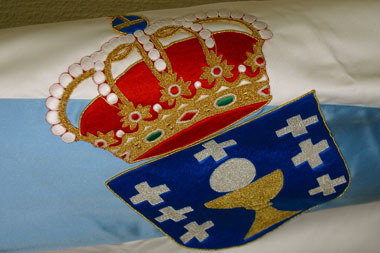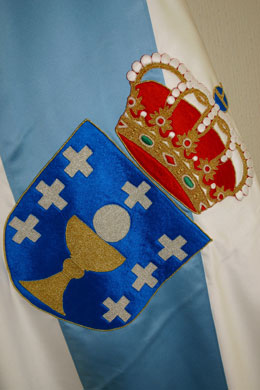
 A sea flag to shelter feelings
A sea flag to shelter feelings
The flag of Galicia was inspired by the Maritime Captaincy of A Coruña with the addition of the coat of arms of the Old Kingdom of Galicia from the XIII century
Like many other flags representing different regions, the Galician institutional flag, consisting of a white background crossed by a transverse strip of sky blue colour from the top left to bottom right, has its origin in the sea. The national emblem itself, consisting of two red stripes with a yellow stripe in the centre and twice the thickness of the other, derived from a competition organized by King Carlos III to provide the Spanish Navy of an emblem that could be easily recognized in the distance and original enough not to be confused with other emblems used by foreign countries in which the white, blue and red were mostly used in their composition and could be easily misleading. The Galician flag was born from the Maritime Captaincy of A Coruña.
The wide and diverse universe of Galician emigrants in Latin America also had a crucial intervention in the choice of this emblem in which the traditional white background is predominantly ingrained in Galicia, and probably used by the so-called Literary Battalion recruited in Compostela to fight against the French during the War of Independence mainly composed of university students and graduates in law. The white flag is a traditional Galician symbol and was chosen by the journalist and writer Antolin Faraldo as an emblem of the so-called Revolution of 46 which ended with the tragic episode of the martyrs of Carral.
 Faraldo, born in Betanzos in 1823, began to express the principles of an emerging regionalist thinking in a magazine called "The Future" which converted the indomitable manifesto of Galician sentiment and independence during 1845, when the moderate government led by Narváez was dedicated to cutting back freedom and rights, suppressing with violence the rebellious outbreaks that abound around the country during this dark decade. The writer added himself in an unconditional way, assuming a significant role in the uprising that started in Lugo against the intolerance of Narváez, coup that started in the Galician geography and ended in a full-scale revolt that ended in blood and drama. The government troops defeated the Galician rebels that were under the orders of General Solis in the battle of Cacheiras and the rebel officer and eleven officers under his command were captured inside the monastery of San Martín Pinario, summarily judged in the village of Carral, and put to the sword the next day, Solis in the atrium of the church of Paleo, and the rest in a nearby forest. Faraldo, involved in the cause, had to flee in a hurry to Portugal so as not to follow the same fate. He returned the following year taking advantage of an amnesty and became a resident in Madrid. His figure vanished and little was heard of him until his early death in Granada in 1853. He was barely thirty years of age.
Faraldo, born in Betanzos in 1823, began to express the principles of an emerging regionalist thinking in a magazine called "The Future" which converted the indomitable manifesto of Galician sentiment and independence during 1845, when the moderate government led by Narváez was dedicated to cutting back freedom and rights, suppressing with violence the rebellious outbreaks that abound around the country during this dark decade. The writer added himself in an unconditional way, assuming a significant role in the uprising that started in Lugo against the intolerance of Narváez, coup that started in the Galician geography and ended in a full-scale revolt that ended in blood and drama. The government troops defeated the Galician rebels that were under the orders of General Solis in the battle of Cacheiras and the rebel officer and eleven officers under his command were captured inside the monastery of San Martín Pinario, summarily judged in the village of Carral, and put to the sword the next day, Solis in the atrium of the church of Paleo, and the rest in a nearby forest. Faraldo, involved in the cause, had to flee in a hurry to Portugal so as not to follow the same fate. He returned the following year taking advantage of an amnesty and became a resident in Madrid. His figure vanished and little was heard of him until his early death in Granada in 1853. He was barely thirty years of age.
However, the current flag which keeps the traditional white background is inspired by the Maritime Captaincy of A Coruña, which the Galician emigrants would see waving in the building of the port in the late nineteenth and early twentieth centuries before leaving the Galician coast bound for abroad. It was a flag equal to the one that was made official with the Law 5/84 of the 29th of May of 1984, but it did not have an emblem with the chalice and the seven crosses that today constitutes the complement to shape the institutional flag, product of the merger between the white and blue flag with the traditional emblem of the XIII century that was already present in the arms of the Ancient Kingdom of Galicia.
The flag, without any attachment, travelled in the minds of the emigrant population that crossed the Atlantic and it consolidated itself as the pennant amongst the Galician's in Havana first, to later be implemented in the scope of the Galician's living abroad. The newspaper, "El Eco de Galicia" edited by the Galicians of Cuba, published in 1898 the standards defining the flag that would represent Galicia in all his acts: "The background is white, and from the upper left corner to lower right corner, across the middle, a blue stripe that should be one third of the total height or width of the flag."
This is how it made its way back to Spain and this is how it has survived until the final consecration of Galicia as an autonomous community that institutionalized its final design and the rules governing its use, adding the symbol of the chalice and the seven medieval crosses over the sky-blue band to define the flag that represents us today.




